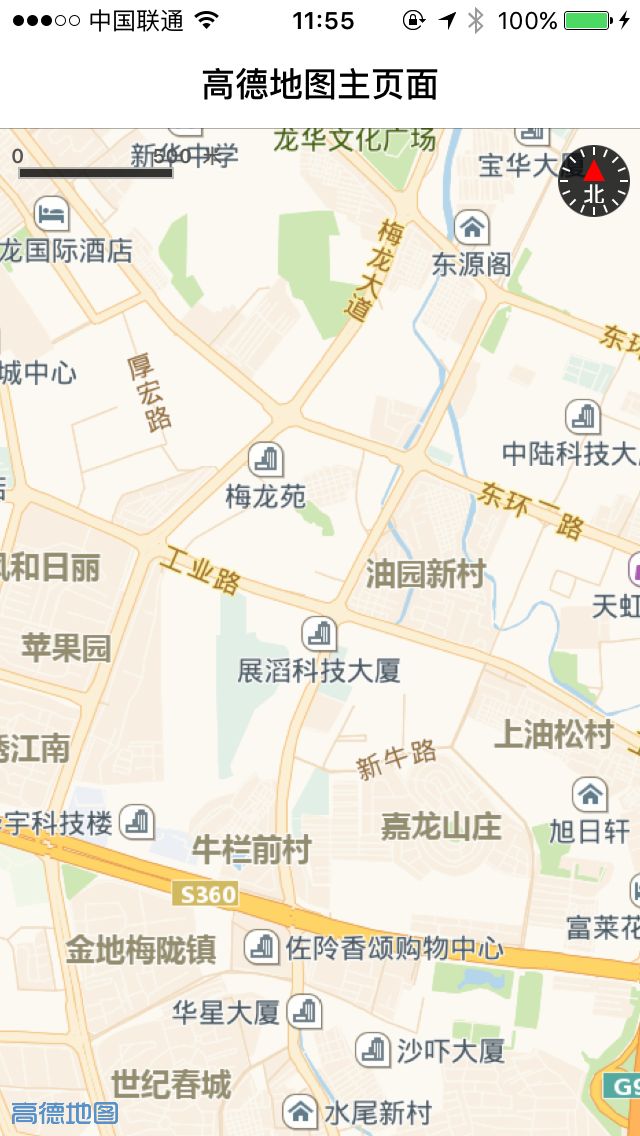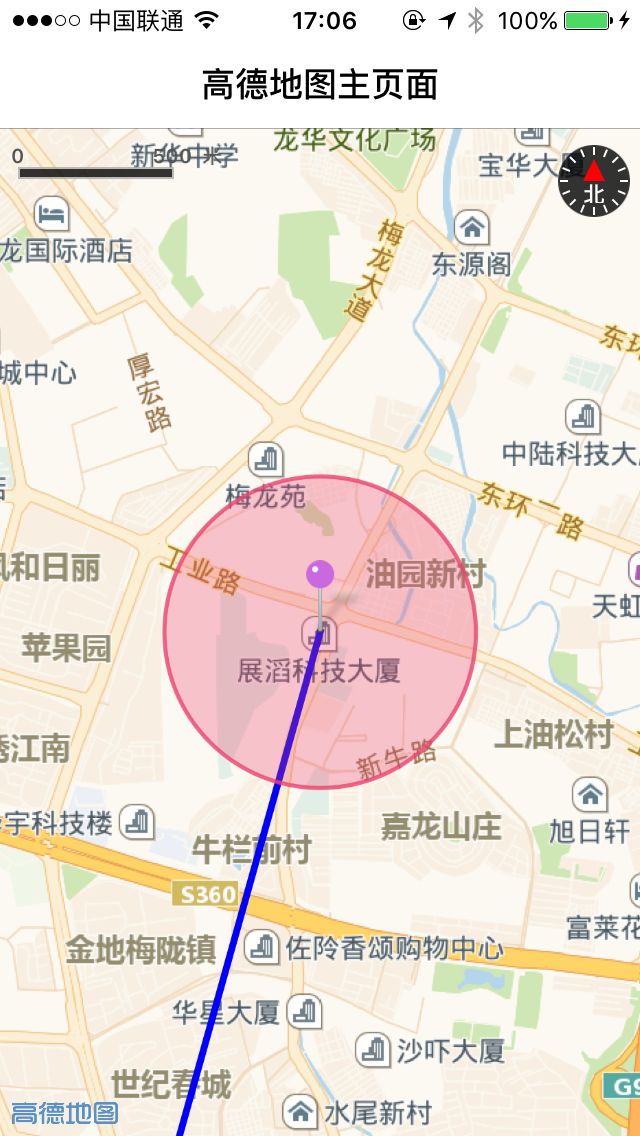欢迎访问我的博客muhlenXi,该文章出自我的博客。
版权声明:本文为muhlenXi原创文章,转载请注明出处,未经允许不得转载.
导语:
高德地图 iOS SDK 是一套基于 iOS 6.0.0 及以上版本的地图应用程序开发接口,供开发者在自己的iOS应用中加入地图相关的功能。通过iOS SDK,开发者可以轻松地开发出地图显示与操作、兴趣点搜索、地理编码、路线规划等功能。
点击阅读全文来瞅瞅如何开发吧。
由于官方文档更新不及时,很多方法弃用了,新的方法只能自己摸索了。本文大部分是参考官方文档来做的。
点这里查看高德开发平台,在这里注册高德账号并成为开发者。
如果是第一次接触高德地图,可以大概看一下入门指南
高德地图SDK的部署
由于我喜欢简单粗暴的部署方式,所以一直选择 CocoaPods来安装和配置第三方库。
关于CocoaPods,不了解的可以看一下我的另一篇博文,zsh的配置和CocoaPods的安装与使用。这里就不详细展开了。
方法就是,使用终端cd到你的项目所在的路径下,vim一个Podfile文件,点击字母i进入编辑状态,在文件中输入:
platform:ios,'7.0'
target 'gaodeMapDemo' do
pod 'AMap2DMap', '~> 3.3.0'
pod 'AMapLocation', '~> 1.2.0' #定位SDK
pod 'AMapSearch' #搜索服务SDK
end
然后按下Esc,shift+:然后输入wq,最后终端输入pod install --verbose --no-repo-update安装即可。
高德地图SDK的打开方式
点这里查看高德地图 iOS SDK。
配置好就可以正式干活了,我们先导入高德地图的头文件#import
先来一个屏幕宽和高的宏定义吧。
#define kScreenWidth [UIScreen mainScreen].bounds.size.width
#define kScreenHeight [UIScreen mainScreen].bounds.size.height
再声明一个mapView的属性。
@property (nonatomic,strong) MAMapView * mapView;
添加地图
自定义一个设置地图的方法setupMap
//设置高德地图
- (void) setupMap
{
[MAMapServices sharedServices].apiKey = gaode_key;
self.mapView = [[MAMapView alloc] initWithFrame:CGRectMake(0, 0, kScreenWidth, kScreenHeight)];
[self.view addSubview:self.mapView];
//设置地图模式
// MAMapTypeSatellite // 卫星地图
// MAMapTypeStandard // 普通地图
self.mapView.mapType = MAMapTypeStandard;
}
在viewDidLoad中调用这个方法,然后编译运行,看看添加的地图长啥样。
会发现基本长这样:
卫星地图基本长这样:
显示实时路况,默认是不显示的
self.mapView.showTraffic = YES;
不显示比例尺,默认是显示的,可以通过compassOrigin属性可改变指南针的显示位置。
self.mapView.showsScale = NO;
//设置比例尺位置
self.mapView.scaleOrigin= CGPointMake(_mapView.scaleOrigin.x, 82);
不显示罗盘,默认是显示的,可以通过scaleOrigin属性可改变改变比例尺的显示位置
self.mapView.showsCompass = NO;
//设置指南针位置
self.mapView.compassOrigin= CGPointMake(_mapView.compassOrigin.x, 82);
高德地图的Logo不能移除,可以通过logoCenter属性来调整Logo的显示位置。
//显示logo在右下角
self.mapView.logoCenter = CGPointMake(kScreenWidth-55, kScreenHeight-13);
设置地图的中心坐标和显示范围
点这里坐标拾取器来获取经纬度吧。
写一个根据经纬度和跨度来设置地图显示范围的方法
- (void) setMapViewDisplayAreaWithLatitude:(double)lati andLongitude:(double) longi Span:(double) span_value
{
CLLocationCoordinate2D center = {lati,longi};
MACoordinateSpan span = {span_value,span_value};
MACoordinateRegion region = {center,span};
[self.mapView setRegion:region animated:YES];
}
在viewDidLoad中调用这个方法。
//设置显示区域为深圳展滔科技大厦114.038072,22.639641
double lati = 22.639641;
double longi = 114.038072;
[self setMapViewDisplayAreaWithLatitude:lati andLongitude:longi Span:0.02];
然后编译运行,结果如下。
添加系统样式的标注
标注可以精确表示用户需要展示的位置信息,高德地图SDK提供的标注功能允许用户自定义图标和信息窗,同时提供了标注的点击、拖动事件的回调。
写一个根据经纬度添加系统样式标注的方法
//添加默认样式的点标记,即大头针
- (void) addPointAnnotationWithLatitude:(double)lati andLongitude:(double) longi Title:(NSString *) title Subtitle:(NSString *) subtitle
{
MAPointAnnotation * pointAnnotation = [[MAPointAnnotation alloc] init];
pointAnnotation.coordinate = CLLocationCoordinate2DMake(lati, longi);
pointAnnotation.title = title;
pointAnnotation.subtitle = subtitle;
[self.mapView addAnnotation:pointAnnotation];
}
在viewDidLoad中添加标注
//添加系统样式标注
[self addPointAnnotationWithLatitude:lati andLongitude:longi Title:@"展滔科技大厦" Subtitle:@"深圳市宝安区民治大道1079号"];
此时编译运行的话,地图上仅仅显示一个红色的大头针,点击大头针没任何反应
我们在软件开发中,设计到协议、代理、回调方法时,一定要切记这三步曲!
- 第一步:遵循协议。
- 第二步:设置代理(这步千万不能忘)!
- 第三步:实现相应代理方法。
第一步遵循
@interface RootViewController ()
第二步设置代理,在setupMap方法中加入如下代码。
//设置地图的代理
self.mapView.delegate = self;
第三步通过实现协议中的 mapView:viewForAnnotation:回调函数,设置标注样式.
#pragma mark - MAMapViewDelegate
- (MAAnnotationView *)mapView:(MAMapView *)mapView viewForAnnotation:(id)annotation
{
if ([annotation isKindOfClass:[MAPointAnnotation class]])
{
//复用标识符
static NSString * pointReuseIndentifier = @"pointReuseIndentifier";
MAPinAnnotationView * annotationView = (MAPinAnnotationView*)[mapView dequeueReusableAnnotationViewWithIdentifier:pointReuseIndentifier];
if (annotationView == nil)
{
annotationView = [[MAPinAnnotationView alloc] initWithAnnotation:annotation reuseIdentifier:pointReuseIndentifier];
}
//设置气泡可以弹出,默认为NO
annotationView.canShowCallout= YES;
//设置标注动画显示,默认为NO
annotationView.animatesDrop = YES;
//设置标注可以拖动,默认为NO
annotationView.draggable = YES;
//设置大头针的颜色,有MAPinAnnotationColorRed, MAPinAnnotationColorGreen, MAPinAnnotationColorPurple三种
annotationView.pinColor = MAPinAnnotationColorPurple;
return annotationView;
}
return nil;
}
此时编译并运行代码,地图上会显示一个紫色的大头针,点击大头针会弹出一个气泡,气泡中显示设置的标题和副标题。如图所示:
添加一组标注用这个方法
//数组中存放的是MAPointAnnotation的对象
NSArray * array = @[pointAnnotation];
[self.mapView addAnnotations:array];
删除一个标注
[self.mapView removeAnnotation:pointAnnotation];
删除一组标注
//数组中存放的是要删除的标注,也是MAPointAnnotation的对象
NSArray * array = @[pointAnnotation];
[self.mapView removeAnnotations:array];
添加自定义样式的标注
自定义标注的效果如图所示:
如果想实现这个效果,我们需要自定义两个View。
- 1、CustomCalloutView : UIView //自定义的气泡
- 2、CustomAnnotationView : MAAnnotationView //自定义的标注View
新建我们的CustomCalloutView:
在CustomCalloutView.h文件中声明我们需要的属性:
@property (nonatomic,strong) UIImage * thumbnail; //!< 缩略图片
@property (nonatomic,copy) NSString * title; //!< 标题
@property (nonatomic,copy) NSString * address; //!< 地址
在CustomCalloutView.m文件中新建一个匿名类(类扩展)声明我们需要的控件:
@interface CustomCalloutView ()
@property (nonatomic,strong) UIImageView * thumbnailImageView; //!< 缩略图
@property (nonatomic,strong) UILabel * titleLabel; //!< 标题Label
@property (nonatomic,strong) UILabel * addressLabel; //!< 地址Label
@end
重写- (instancetype)initWithFrame:(CGRect)frame方法,初始化我们的控件
- (instancetype)initWithFrame:(CGRect)frame
{
self = [super initWithFrame:frame];
if (self) {
//其他控件的初始化写在这里
self.backgroundColor = [UIColor clearColor];
//初始化缩略图
self.thumbnailImageView = [[UIImageView alloc] initWithFrame:CGRectMake(5, 5, 70, 50)];
self.thumbnailImageView.backgroundColor = [UIColor yellowColor];
[self addSubview:self.thumbnailImageView];
//初始化标题Label
self.titleLabel = [[UILabel alloc] initWithFrame:CGRectMake(5+70+5, 5, 120-8, 20)];
self.titleLabel.font = [UIFont systemFontOfSize:14];
self.titleLabel.textColor = [UIColor whiteColor];
self.titleLabel.text = @"title";
[self addSubview:self.titleLabel];
//初始化地址Label
self.addressLabel = [[UILabel alloc] initWithFrame:CGRectMake(5+70+5, 20, 120-8, 20*2)];
self.addressLabel.font = [UIFont systemFontOfSize:12];
self.addressLabel.numberOfLines = 0;
self.addressLabel.textColor = [UIColor lightGrayColor];
self.addressLabel.text = @"address";
[self addSubview:self.addressLabel];
}
return self;
}
重写CustomCalloutView.h文件中声明的属性的Setter方法,方便我们给控件赋值:
- (void)setTitle:(NSString *)title
{
self.titleLabel.text = title;
}
- (void)setAddress:(NSString *)address
{
self.addressLabel.text = address;
}
- (void)setThumbnail:(UIImage *)thumbnail
{
self.thumbnailImageView.image = thumbnail;
}
最后重写- (void)drawRect:(CGRect)rect方法绘制我们气泡的背景和添加阴影效果:
- (void)drawRect:(CGRect)rect
{
//绘制曲线
CGContextRef contextRef = UIGraphicsGetCurrentContext();
CGContextSetLineWidth(contextRef, 2.0f);
CGContextSetFillColorWithColor(contextRef, [UIColor colorWithRed:0.3 green:0.3 blue:0.3 alpha:0.8].CGColor);
CGRect calloutRect = self.bounds;
CGFloat radius = 6.0;
CGFloat triangleHeight = 10; //倒三角的高度
CGFloat x = CGRectGetMinX(calloutRect);
CGFloat midX = CGRectGetMidX(calloutRect);
CGFloat width = CGRectGetMaxX(calloutRect);
CGFloat y = CGRectGetMinY(calloutRect);
CGFloat height = CGRectGetMaxY(calloutRect)-10;
//用起始点开始
CGContextMoveToPoint(contextRef, x+radius, y);
//画上面的直线
CGContextAddLineToPoint(contextRef, x+width-radius, y);
//画右上角圆弧
CGContextAddArcToPoint(contextRef, x+width, y, x+width, y+radius, radius);
//画右边的直线
CGContextAddLineToPoint(contextRef, x+width, y+height-radius);
//画右下角弧线
CGContextAddArcToPoint(contextRef, x+width, y+height, x+width-radius, y+height, radius);
//画倒三角靠右的下边的直线
CGContextAddLineToPoint(contextRef, midX+triangleHeight, y+height);
//画倒三角
CGContextAddLineToPoint(contextRef, midX, y+height+triangleHeight);
CGContextAddLineToPoint(contextRef, midX-triangleHeight, y+height);
//画倒三角靠左的下边的直线
CGContextAddLineToPoint(contextRef, x+radius, y+height);
//画左下角的弧线
CGContextAddArcToPoint(contextRef, x, y+height, x, y+height-radius, radius);
//画左边的直线
CGContextAddLineToPoint(contextRef, x, y+radius);
//画左上角的弧线
CGContextAddArcToPoint(contextRef, x, y, x+radius, y, radius);
CGContextClosePath(contextRef);
CGContextFillPath(contextRef);
//添加阴影
self.layer.shadowColor = [[UIColor blackColor] CGColor];
//阴影的透明度
self.layer.shadowOpacity = 1.0f;
//阴影的偏移
self.layer.shadowOffset = CGSizeMake(0, 0);
}
到这里我们的自定义气泡就大功告成了!
新建我们的CustomAnnotationView:
新建一个继承自MAAnnotationView的CustomAnnotationView,在 CustomAnnotationView.h文件中,导入前面的自定义气泡的头文件:
#import "CustomCalloutView.h"
声明一个气泡的属性:
@property (nonatomic,strong) CustomCalloutView * calloutView;
�```
在`CustomAnnotationView.m`文件中重写标注选中的方法`- (void)setSelected:(BOOL)selected animated:(BOOL)animated`:
```objc
//重写选中方法setSelected
- (void)setSelected:(BOOL)selected animated:(BOOL)animated
{
if (self.selected == selected) {
return;
}
if (selected == YES) {
//如果气泡为空则初始化气泡
if (self.calloutView == nil) {
self.calloutView = [[CustomCalloutView alloc] initWithFrame:CGRectMake(0, 0, 200, 70)];
//设置气泡的中心点
CGFloat center_x = self.bounds.size.width/2;
CGFloat center_y = -self.bounds.size.height;
self.calloutView.center = CGPointMake(center_x, center_y);
}
//给calloutView赋值
self.calloutView.thumbnail = [UIImage imageNamed:@"zhantao"];
self.calloutView.title = self.annotation.title;
self.calloutView.address = self.annotation.subtitle;
[self addSubview:self.calloutView];
} else {
//移除气泡
[self.calloutView removeFromSuperview];
}
[super setSelected:selected animated:animated];
}
到这里我们的自定义标注View也完成了,接下来就能使用了
在我们的地图的标注回调函数mapView: viewForAnnotation:中设置我们的CustomAnnotationView:
- (MAAnnotationView *)mapView:(MAMapView *)mapView viewForAnnotation:(id)annotation
{
if ([annotation isKindOfClass:[MAPointAnnotation class]])
{
static NSString * reuseIndetifier = @"annotationReuseIndetifier";
CustomAnnotationView * annotationView = (CustomAnnotationView *)[mapView dequeueReusableAnnotationViewWithIdentifier:reuseIndetifier];
if (annotationView == nil)
{
annotationView = [[CustomAnnotationView alloc] initWithAnnotation:annotation reuseIdentifier:reuseIndetifier];
annotationView.image = [UIImage imageNamed:@"dingfen"];
///设置中心点偏移,使得标注底部中间点成为经纬度对应点
annotationView.centerOffset = CGPointMake(0, -15);
return annotationView;
}
}
return nil;
}
如果没问题的话,运行的结果会和前面提到的效果图一致的!
标注移动的回调处理
当我们长按住大头针时会移动大头针在地图上的位置。高德地图会回调如下方法
//移动标注会调用这个方法
- (void)mapView:(MAMapView *)mapView annotationView:(MAAnnotationView *)view didChangeDragState:(MAAnnotationViewDragState)newState fromOldState:(MAAnnotationViewDragState)oldState
{
//标注停止移动时
if (newState == MAAnnotationViewDragStateEnding)
{
//获取标注新的位置所在的经纬度坐标
CGPoint endPoint = view.centerOffset;
CLLocationCoordinate2D coo = [mapView convertPoint:endPoint toCoordinateFromView:view];
NSLog(@"移动后大头针的经纬度:latitude = %f longitude = %f",coo.latitude,coo.longitude);
}
}
在地图上移动大头针后,会输出如下结果:
2016-09-27 16:49:35.255 gaodeMapDemo[5930:2794113] 移动后大头针的经纬度:latitude = 22.646707 longitude = 114.035228
添加折线
官网中指导的代理回调方法已经弃用了,还未做出更新!
自定义一个绘制折线的方法,代码中的坐标需要根据实际项目需求调整
//绘制折线
- (void) addPolyLineOnMap
{
NSInteger count = 5;
CLLocationCoordinate2D commonPolylineCoords[count];
//起点:展滔科技大厦
commonPolylineCoords[0].latitude = 22.639641;
commonPolylineCoords[0].longitude = 114.038072;
//北站114.02887,22.609235
commonPolylineCoords[1].latitude = 22.609235;
commonPolylineCoords[1].longitude = 114.02887;
//民乐地铁站114.048809,22.594144
commonPolylineCoords[2].latitude = 22.594144;
commonPolylineCoords[2].longitude = 114.048809;
//东站114.119699,22.60225
commonPolylineCoords[3].latitude = 22.60225;
commonPolylineCoords[3].longitude = 114.119699;
//终点:坂田114.06942,22.634804
commonPolylineCoords[4].latitude = 22.634804;
commonPolylineCoords[4].longitude = 114.06942;
//构造折线对象
MAPolyline *commonPolyline = [MAPolyline polylineWithCoordinates:commonPolylineCoords count:count];
//在地图上添加折线对象
[self.mapView addOverlay: commonPolyline];
}
实现协议中的 mapView:rendererForOverlay:回调函数,设置折线样式。
- (MAOverlayRenderer *)mapView:(MAMapView *)mapView rendererForOverlay:(id)overlay
{
if ([overlay isKindOfClass:[MAPolyline class]]) {
NSLog(@" MAPolylineRenderer 调用了");
MAPolylineRenderer * lineRenderer = [[ MAPolylineRenderer alloc] initWithOverlay:overlay];
//折线宽度
lineRenderer.lineWidth = 5.0f;
//折线的颜色
lineRenderer.strokeColor = [UIColor blueColor];
//折线起始点类型
lineRenderer.lineJoin = kCGLineJoinBevel;
//折线终点类型
lineRenderer.lineCap = kCGLineJoinBevel;
return lineRenderer;
}
return nil;
}
在``中调用该方法添加折线:
//添加折线
[self addPolyLineOnMap];
编译并运行代码,会出现一条蓝色的折线。如图所示:
删除折线
//commonPolyline是要删除的折线,是MAPolyline的对象
[self.mapView removeOverlay:commonPolyline];
添加圆形覆盖物
首先,在viewDidLoad中添加如下代码来添加圆圈:
//添加圆形覆盖物,radius指的是圆圈的半径
MACircle *Circle1 = [MACircle circleWithCenterCoordinate:CLLocationCoordinate2DMake(lati, longi) radius:500];
[self.mapView addOverlay:Circle1];
然后,在协议中的 mapView:rendererForOverlay:回调函数,中添加代码来设置圆圈样式。
将下面的代码加到return nil;的前面!
//如果是圆形覆盖物
if ( [overlay isKindOfClass:[MACircle class]]) {
NSLog(@" MACircleRenderer 调用了");
MACircleRenderer * circleRenderer = [[MACircleRenderer alloc] initWithOverlay:overlay];
//设置圆圈的圆边的宽度
circleRenderer.lineWidth = 3.0f;
//圆边的颜色
circleRenderer.strokeColor = [UIColor colorWithRed:236/255.0 green:65/255.0 blue:110/255.0 alpha:0.8];
//设置圆圈的填充颜色
circleRenderer.fillColor = [UIColor colorWithRed:236/255.0 green:65/255.0 blue:110/255.0 alpha:0.3];
return circleRenderer;
}
编译运行代码,刚添加的圆圈如下所示:
如果想在移动标注的时候删除圈圈,然后在新的标注点添加圆圈,需要修改didChangeDragState代理方法中的代码!,修改如下:
//移动标注会调用这个方法
- (void)mapView:(MAMapView *)mapView annotationView:(MAAnnotationView *)view didChangeDragState:(MAAnnotationViewDragState)newState fromOldState:(MAAnnotationViewDragState)oldState
{
//标注移动时
if (newState == MAAnnotationViewDragStateStarting) {
NSArray * overlays = mapView.overlays;
MACircle * cicle = [[MACircle alloc] init];
for (NSInteger i = 0; i < overlays.count; i++) {
//如果是圈圈则删除
if ([overlays[i] isKindOfClass:[cicle class]]) {
[mapView removeOverlay:overlays[i]];
}
}
}
//标注停止移动时
if (newState == MAAnnotationViewDragStateEnding)
{
//获取标注新的位置所在的经纬度坐标
CGPoint endPoint = view.centerOffset;
//修正一下位置
endPoint.x = endPoint.x + 22;
endPoint.y = endPoint.y + 36;
CLLocationCoordinate2D coo = [mapView convertPoint:endPoint toCoordinateFromView:view];
NSLog(@"移动后大头针的经纬度:latitude = %f longitude = %f",coo.latitude,coo.longitude);
//添加新的圈圈
MACircle * Circle1 = [MACircle circleWithCenterCoordinate:coo radius:500];
[mapView addOverlay:Circle1];
}
}
编译运行代码,移动标注后,新添加的圆圈如下所示:
高德地图的地图SDK到这里就告一段落了
定位SDK的打开方式
点这里查看iOS 定位 SDK.
导航SDK的打开方式
点这里查看iOS 导航 SDK .
关于导航,可以参考我的这篇博文。
iOS实现应用外自带地图、高德地图、百度地图导航
室内地图SDK的打开方式
点这里查看iOS 室内地图SDK
室内定位SDK的打开方式
点这里查看iOS 室内定位SDK
结束语
本文会阶段性的持续更新的!欢迎大家批评和指正!
点击下载本文的demo,记得给star支持博主的努力哦!
感谢阅读,有什么意见可以给我留言!






